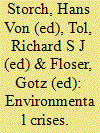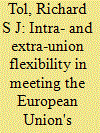|
|
|
Sort Order |
|
|
|
Items / Page
|
|
|
|
|
|
|
| Srl | Item |
| 1 |
ID:
112897


|
|
|
|
|
| Publication |
2012.
|
| Summary/Abstract |
This paper investigates the economic implications of disruptions of one to ninety days to the supply of natural gas in Ireland. We assess the impact of a hypothetical gas supply disruption in both winter and summer in 2008 (with observed market characteristics) and in 2020 (with projected market characteristics). The cost of a natural gas outage includes the cost of natural gas being unavailable for heating and other purposes in the industrial and commercial sectors, lost consumer surplus in the residential sector, the cost of lost electricity in all sectors and lost VAT on the sale of gas and electricity. Ireland generates much of its electricity from natural gas and the loss of this electricity accounts for the majority of the cost of a natural gas outage. Losing gas-fired electricity would cost 0.1-1.0 billion euro per day, depending on the time to the week, the time of year and rationing. Industry should be rationed before households to minimise economic losses, but current emergency protocols do the opposite. If gas-fired electricity is unavailable for three months, the economic loss could be up to 80 billion euro, about half of Gross Domestic Product. Losing gas for heating too would add up to approximately 8 billion euro in economic losses. We also discuss some options to increase Ireland's security of supply, and find that the cost is a small fraction of the avoided maximum damage.
|
|
|
|
|
|
|
|
|
|
|
|
|
|
|
|
| 2 |
ID:
115655


|
|
|
|
|
| Publication |
2012.
|
| Summary/Abstract |
The European Commission did not publish a cost-benefit analysis for its 2020 climate package. This paper fills that gap, comparing the marginal costs and benefits of greenhouse gas emission reduction. The uncertainty about the marginal costs of climate change is large and skewed, and estimates partly reflect ethical choices (e.g., the discount rate). The 2010 carbon price in the EU Emissions Trading System can readily be justified by a cost-benefit analysis. Emission reduction is not expensive provided that policy is well-designed, a condition not met by planned EU policy. It is probably twice as expensive as needed, costing one in ten years of economic growth. The EU targets for 2020 are unlikely to meet the benefit-cost test. For a standard discount rate (3% pure rate of time preference), the benefit-cost ratio is rather poor (1/30)-so that benefits need to be very much higher, or costs very much lower than typically assumed to justify the 2020 targets. Only a very low discount rate (0% PRTP) would justify the 20% emission reduction target for 2020.
|
|
|
|
|
|
|
|
|
|
|
|
|
|
|
|
| 3 |
ID:
081882


|
|
|
|
|
| Publication |
Berlin, Springer, 2008.
|
| Description |
142p.
|
| Standard Number |
9783540758952
|
|
|
|
|
|
|
|
|
|
|
|
Copies: C:1/I:0,R:0,Q:0
Circulation
| Accession# | Call# | Current Location | Status | Policy | Location |
| 053533 | 363.7/STO 053533 | Main | On Shelf | General | |
|
|
|
|
| 4 |
ID:
103446


|
|
|
|
|
| Publication |
2011.
|
| Summary/Abstract |
This paper estimates the value of short term lost load in the all island electricity market, which includes the Republic of Ireland and Northern Ireland. The value of lost load (VoLL) is the average willingness of electricity consumers to pay to avoid an additional period without power. VoLL is also known as the value of security of electricity supply and is inferred using a production function approach. Detailed electricity use data for the Republic of Ireland allows us to estimate the value of lost load by time of day, time of week and type of user. We find that the value of lost load is highest in the residential sector in both the Republic of Ireland and Northern Ireland. Our results can be used to advise policy decisions in the case of supply outages and to encourage optimum supply security. In the context of this study short term is taken to be a matter of hours rather than days or weeks.
|
|
|
|
|
|
|
|
|
|
|
|
|
|
|
|
| 5 |
ID:
110380


|
|
|
|
|
| Publication |
2011.
|
| Summary/Abstract |
We examine the impact of recent tax reforms in Ireland on private car transport and its greenhouse gas emissions. A carbon tax was introduced on fuels, and purchase (vehicle registration) and ownership (motor) taxes were switched from engine size to potential emissions. We use a demographic model of the car stock (by age, size, and fuel) and a car purchase model that reflects the heterogeneous distribution of mileage and usage costs across various engine sizes. The model shows a dramatic shift from petrol to diesel cars, particularly for large engines. The same pattern is observed in the latest data on car sales. This has a substantial impact on tax revenue as car owners shift to the lower tax rates. The tax burden has shifted from car ownership to car use, and that the overall tax burden on private car transport falls. As diesel engines are more fuel efficient than petrol engines, carbon dioxide emissions fall modestly or, if we consider the rebound effect of travel costs on mileage, minimally. From the perspective of the revenue, the costs per tonne of carbon dioxide avoided are (very) high.
|
|
|
|
|
|
|
|
|
|
|
|
|
|
|
|
| 6 |
ID:
092578


|
|
|
|
|
| Publication |
2009.
|
| Summary/Abstract |
The EU has proposed four flexibility mechanisms for the regulation of greenhouse gas emissions in the period 2013-2020: (1) the Emissions Trade Scheme (ETS), a permit market between selected companies; (2) trade in non-ETS allotments between Member States; (3) the Clean Development Mechanism (CDM) to purchase offsets in developing countries; and (4) trade in CDM warrants between Member States. This paper shows that aggregate abatement costs fall as flexibility increases. However, limited flexibility creates rents so that increasing flexibility raises costs in some Member States. Costs are reduced more by the CDM than by non-ETS trade. The CDM warrants market reduces costs by a small amount only; market power is a real issue. However, the warrants market is obsolete in case there is non-ETS trade. The CDM leads to price convergence between the ETS and non-ETS market. There would be one price for carbon in the European Union if the proposed limits on CDM access are relaxed slightly.
|
|
|
|
|
|
|
|
|
|
|
|
|
|
|
|
| 7 |
ID:
116980


|
|
|
|
|
| Publication |
2012.
|
| Summary/Abstract |
We present a mixed-integer, linear programming model for determining optimal interconnection for a given level of renewable generation using a cost minimisation approach. Optimal interconnection and capacity investment decisions are determined under various targets for renewable penetration. The model is applied to a test system for eight regions in Northern Europe. It is found that considerations on the supply side dominate demand side considerations when determining optimal interconnection investment: interconnection is found to decrease generation capacity investment and total costs only when there is a target for renewable generation. Higher wind integration costs see a concentration of wind in high-wind regions with interconnection to other regions.
|
|
|
|
|
|
|
|
|
|
|
|
|
|
|
|
| 8 |
ID:
125521


|
|
|
|
|
| Publication |
2013.
|
| Summary/Abstract |
We estimate the gross margin that is earned from the supply of electricity to households in Ireland. Using half hourly electricity demand data, the system marginal price (also called the wholesale price) and the retail price of electricity, we analyse how the gross margin varies across customers with different characteristics. The wholesale price varies throughout the day, thus, the time at which electricity is used affects the gross margin. The main factor in determining gross margin, however, is the level of demand.
The highest gross margins are earned from supplying customers that have the following characteristics: being aged between 46 and 55, having a household income of at least €75,000 per annum, being self-employed, having a third-level education, having a professional or managerial occupation, living in a household with seven or more people, living in a detached house, having at least five bedrooms or being a mortgage holder.
An OLS regression shows that gross margin is partly explained by the energy conservation measures which are present in a household; the number of household members; the number of bedrooms; age; occupation; and accommodation-type.
|
|
|
|
|
|
|
|
|
|
|
|
|
|
|
|
| 9 |
ID:
125765


|
|
|
|
|
| Publication |
2013.
|
| Summary/Abstract |
We have modelled the market for new cars in Ireland with the aim of quantifying the values placed on a range of observable car characteristics. Mid-sized petrol cars with a manual transmission sell best. Price and perhaps fuel cost are negatively associated with sales, and acceleration and perhaps range are positively associated. Hybrid cars are popular. The values of car characteristics are then used to simulate the likely market shares of three new electric vehicles. Electric vehicles tend to be more expensive even after tax breaks and subsidies are applied, but we assume their market shares would benefit from an "environmental" premium similar to those of hybrid cars. The "environmental" premium and the level of subsidies would need to be raised to incredible levels to reach the government target of 10% market penetration of all-electric vehicles.
|
|
|
|
|
|
|
|
|
|
|
|
|
|
|
|
|
|
|
|
|